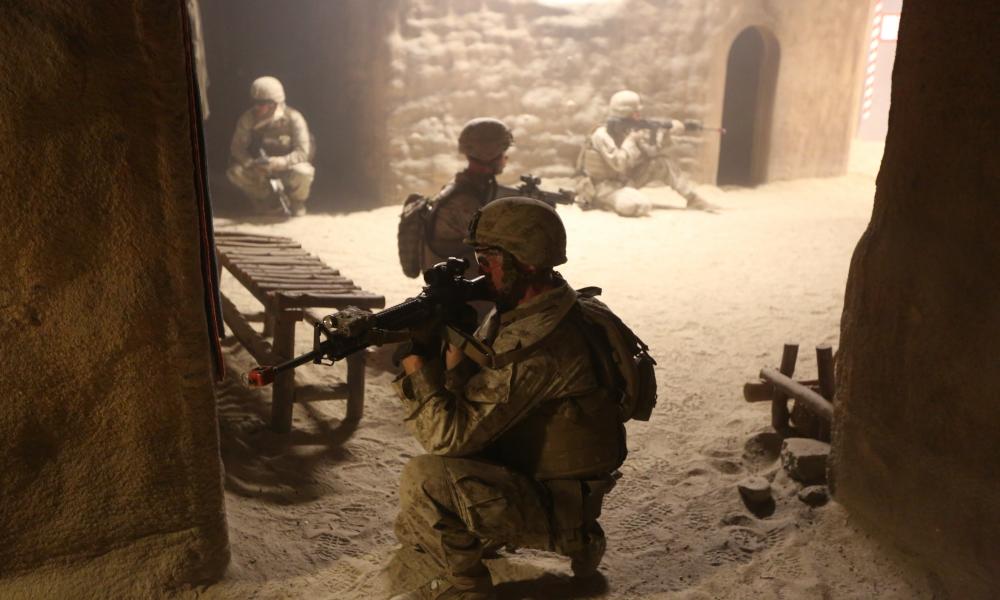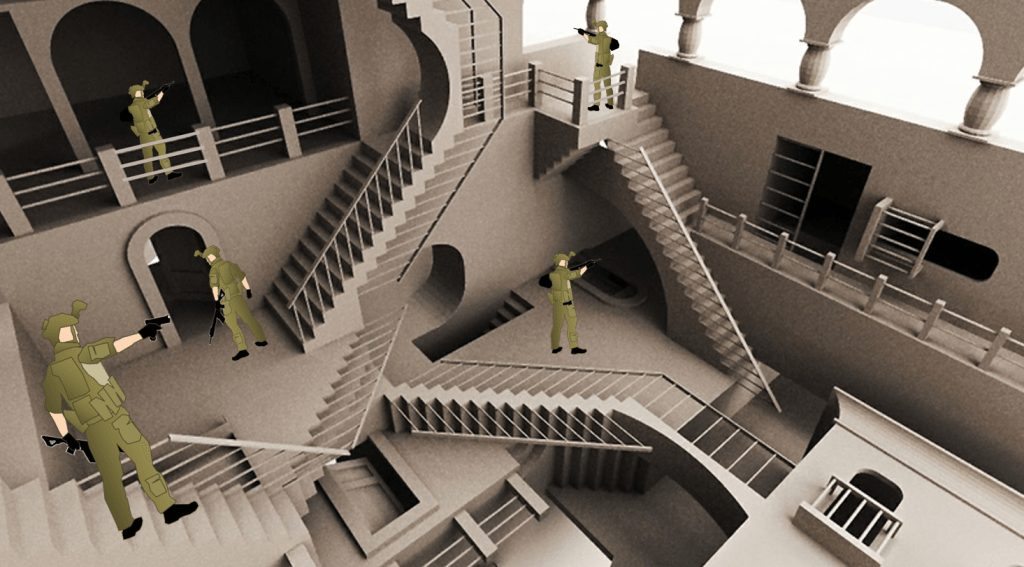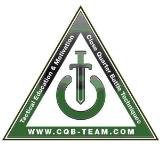Close Quarter Battle Articles
Article One: The Anatomy of the Room
Part 2
Where did we leave off? Oh yeah… Not all rooms are made equal. There’s different shapes and sizes. Some are small, some medium, some large. This is termed short rooms and large rooms. That’s so easy I’m not even going to show you a diagram of it. In places like Afghanistan there are a lot of short rooms – both in size and height – therefore it’s a key consideration when working within that environment.
A short room is small, entries usually only permit around two people… so call it if you come across a short room. An example might be a small outhouse or outbuilding – a shed, an out-house toilet, a storage building or a barn. Get it? Back to heavy and weak side. Let me explain further.
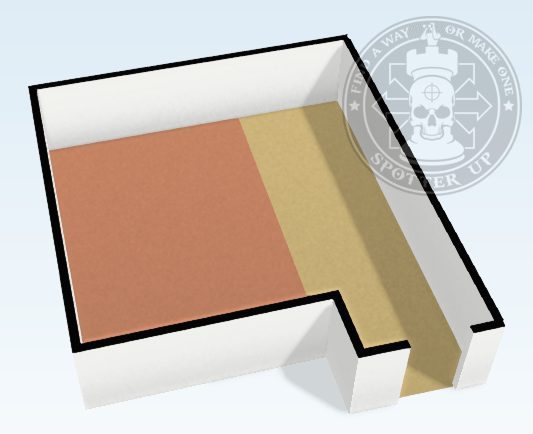
So as you can see, in a box-shaped, corner-fed room that “runs” or “feeds” to the left, the heavy side is situated on the left. It has the largest unknown area left to clear. Teams usually clear from known to unknown so the left side would be their target area to clear.
Entrypoint placement is a tick. Room structure is a tick. Let’s look at the room again but this time with consideration towards the rest of the layout – starting with the corners. The corners that you can see from the entrypoint are called easy corners. The corners you cannot see from the entrypoint are called hard corners. Now looking at a consistently regular box-room with the same length walls on each face of the room, we can see that the easy corners would be the corners furthest away from the entrypoint. This is nearly always true – easy corners tend to be further away.
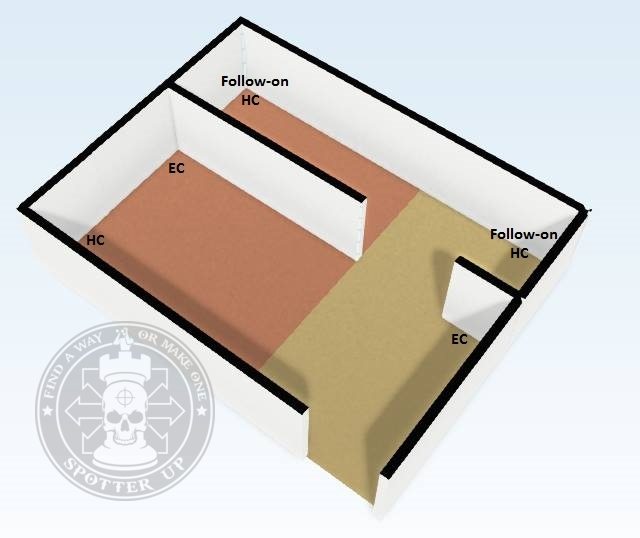
This is important because what we can see, we can examine and engage. From the entrypoint, if we can see the easy corners, we can engage into them before meeting threshold* and pulling into the hard corners. If we see bad news like a boobytrap, we can pull away. This gives you a time and space advantage to the entry. It also leaves you with the understanding that hard corners are rather significant because you cannot see them until you physically enter the room. They are essentially blind spots. Of course, that is unless you have an observation device** and so on, but you get the point.
*The threshold will be discussed in later articles. Google is your friend for now.
**For clarification… like a folding lightweight periscope or under-door camera. They can see into corners without a human physically entering the room.
Remember that you do not always come across regular and consistent walls. In some rooms there will be more hard corners than easy corners or vice versa. Think back to those L-shaped rooms. You do not know what’s around the bend!
Further so, remember back to center-fed and corner-fed rooms, you will note that a box-shaped center-fed room in the diagram above has two hardcorners whereas the box-shaped corner-fed room has one hardcorner. This is tactically significant. We see center-fed rooms as rooms that are therefore “harder” to clear in theory because there are more areas that we are “blind” to from the entrypoint.
All other corners that present themselves that could not be seen or were not expected are follow-on hard corners. They are secondary corners that are often not factored into the initial room entry. You may call them “unknowns” for unknown areas. “Unknown left”, it does not matter the terminology as long as you and your team understand it. Treat them as any corner, as I will show you in later articles.
So let me break this down for you as easily as possible before moving on.
Rooms
Center-fed room – A room whose entrypoint is situated in or closest to the center of the wall. This does not have to mean that both walls abreast to the door have to be of equal length. It usually means that the door opens into, reasonably, the center of the room.
Corner-fed room – A room whose entrypoint is situated on or closest to the corner of the wall, as opposed to the center of the wall.
Box-shaped room – A square-shaped room with four corners.
Linear room – A usually straight and elongated room. This may have easily visible corners within it. For example a hallway.
L-shaped room – A typically square-shaped room with elongated projection coming from it. This is seen in the the alphabetical “L” letter shape.
Heavy side of the room – From the entrypoint the heavy side is the biggest area of the room.
Weak side of the room – From the entrypoint the weak side is the smallest area of the room.
Corners
Hard corner – A corner that cannot be seen from the entrypoint. This may require you to physically enter the room to see into it. They may also be known as shallow, unseen, unknown corners.
Soft corner – A corner that can be seen from the entrypoint. They should be observed prior to or during entry. They may also be known as easy, deep, seen, known corners.
Primary corners – An expected corner one comes up against within the room entry. This includes the: Hard corner and Soft corner.
Secondary corners – A corner one comes across, ordinarily, post-entry. It may be unexpected and catch you off guard. This includes the: Follow-on hard corner.
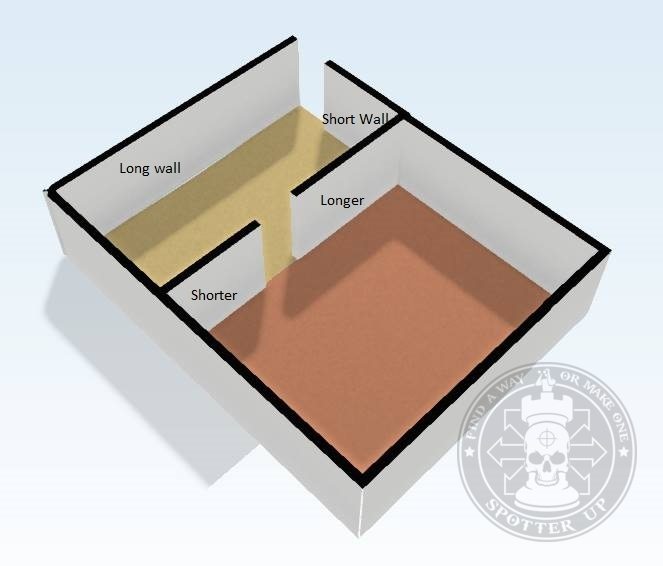
The last part of the room that we shall cover for this part in the series is differentiating between the short wall and the long wall. Previously I told you that most rooms are not made equal, that is, among other things, that their walls differ in length.
This may not seem significant at first but there is something known as “running the long wall” or “running the short wall” depending on what wall you move along. You want to use these areas to your advantage. Distance is time and gaining distance from the entrypoint might bend the odds in your favour. In this case you might run the long wall. But that’s all to come in future editions, for now know there is a difference.
Walls
Short Wall – The shortest wall in the room, usually the one attached to and closest to the entrypoint of which the entry team can use.
Long Wall – The longest wall in the room, usually the one attached to and closest to the entrypoint of which the entry team can use.

Now that is it for the basic anatomy. We’re going to next learn how to use that anatomy and build on these concepts. Then we will explain obstacles that may be additional to the base anatomy.
There’s more you can learn about, don’t get me wrong. Window and windowless rooms, T-shaped and U-shaped rooms, opposing doors versus offset doors, open versus closed doors, strong versus weak side of the door, singular and successive rooms, open-top and closed-top areas, overhangs, primary versus secondary landings, balconies, switch-back versus quarter-back stairs, you name it. There’s far too much I could ramble on about that would be very scenario specific so let’s do with what we’ve got.
The stuff that really matters for room anatomy has been covered. Let’s use it. Understood? Comprehende? Time to move on to Part 3.
By Rye
*We’re pleased if your website uses our Anatomy of a Room images but please credit us by using a hyperlink to Spotter Up or by not cutting off our watermark from the images we created. Please do not read too much into the weapons position of the shooters in the illustrations; they are artist’s afterthoughts added on to the room diagrams to make it look more interesting.
If you like this article please LIKE and SHARE!
CQB-TEAM
Close Quarters Battle
Tactical Education and Motivation
Google anything Close Quarter Battle – You’ll find us!
http://www.facebook.com/CQBteam
Picture courtesy of www.mca-marines.org
Drawings created by Spotter Up

